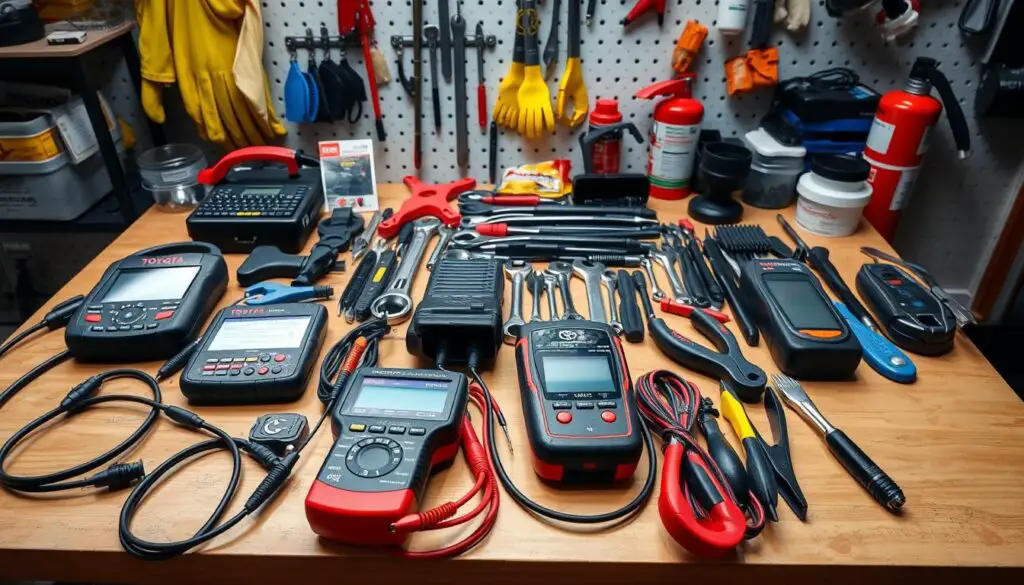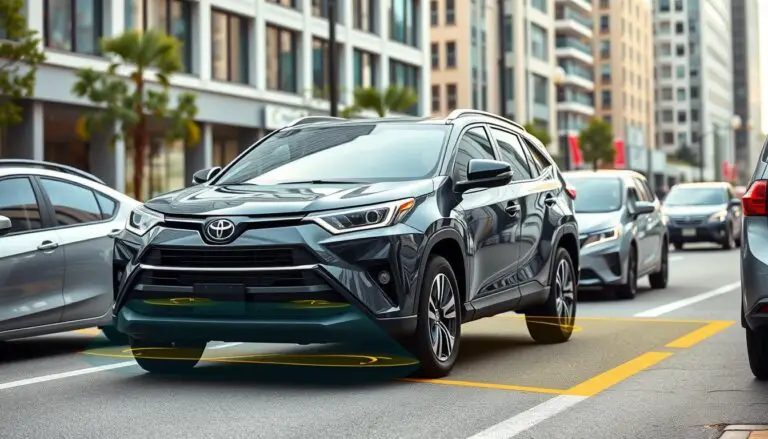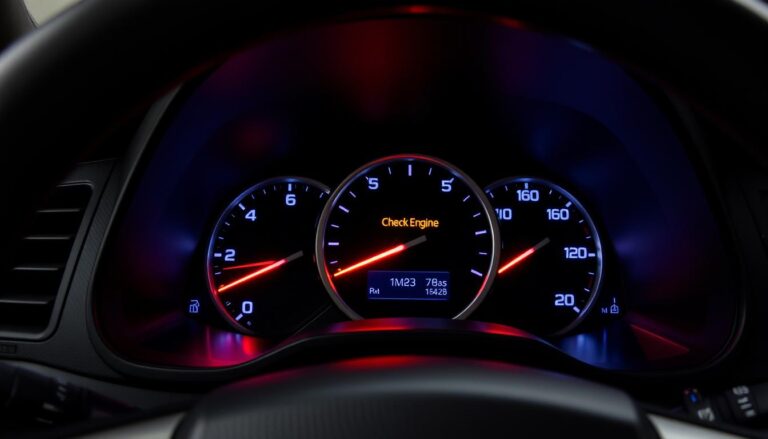Dealing with a vehicle that refuses to start can be frustrating, especially when it has power. If you’re experiencing this issue with your Toyota, you’re not alone. Many owners face this problem, and it’s often a sign of an underlying issue that needs to be addressed.
The problem can stem from various causes, ranging from a faulty battery or alternator to more complex issues with the starter motor or ignition system. Understanding the root cause is crucial to fixing the problem efficiently.
In this article, we’ll guide you through the steps to diagnose and potentially fix the issue, empowering you to get back on the road.
Key Takeaways
- Identify common causes of a Toyota not starting despite having power.
- Learn the initial steps to diagnose the issue.
- Understand when to seek professional help.
- Discover potential fixes for common problems.
- Gain insights into preventive measures to avoid future issues.
Understanding Why Your Toyota Won’t Start But Has Power
Dealing with a Toyota that has power but won’t start can be a challenging experience. To effectively troubleshoot this issue, it’s essential to understand the common symptoms and potential causes.
Common Symptoms in Toyota Vehicles
Toyota vehicles that won’t start but have power often exhibit specific symptoms. These may include:
- Dimmable or flickering dashboard lights
- A clicking sound when turning the key
- The radio and other accessories functioning normally
- A completely dead or unresponsive engine
Differentiating Between Electrical and Mechanical Issues
To diagnose the problem, it’s crucial to differentiate between electrical and mechanical issues. Electrical problems might involve a dead battery, faulty starter motor, or issues with the ignition switch. Mechanical issues, on the other hand, could be related to the engine or transmission. Understanding these differences is key to identifying the root cause.
Essential Tools and Safety Precautions
To effectively diagnose your Toyota, you’ll need to be equipped with the right tools and knowledge. Before starting, it’s essential to understand the basic tools required and the safety measures to take.
Basic Tools Needed for Toyota Diagnosis
A basic toolkit for diagnosing your Toyota should include a multimeter, a set of socket wrenches, and a scan tool. The multimeter is crucial for checking electrical circuits, while the socket wrenches are necessary for accessing various parts of the engine. A scan tool can help you diagnose issues by reading trouble codes from your Toyota’s onboard computer.

Safety Measures When Working on Your Vehicle
When working on your Toyota, safety should be your top priority. Ensure you are wearing protective gear such as gloves and safety glasses. Always disconnect the battery before starting work on electrical systems to avoid short circuits. It’s also important to consult your owner’s manual or a repair manual specific to your Toyota model for guidance.
By following these guidelines, you can ensure a safe and effective diagnosis process.
Quick Checks Before Advanced Troubleshooting
Before diving into complex troubleshooting, it’s essential to perform some quick checks to identify potential causes for your Toyota’s starting issue. These initial checks can often resolve the problem or provide valuable insights into the root cause.
Verifying the Transmission is in Park or Neutral
First, ensure that your Toyota’s transmission is in Park or Neutral. Sometimes, the vehicle might not recognize the gear position correctly, or the shifter might not be fully engaged. Double-check that the gear selector is properly positioned, as this is a common oversight.
Checking for Dashboard Warning Lights
Next, inspect your dashboard for any warning lights. Modern Toyotas are equipped with sophisticated diagnostic systems that illuminate specific lights when a problem is detected. Check if lights such as the check engine light or others related to the starting system are on. These lights can provide crucial clues about the issue.
Testing the Key Fob Battery and Smart Key System
A weak or dead key fob battery can sometimes prevent your Toyota from starting. Try replacing the battery or using the spare key to see if it resolves the issue. Additionally, if your Toyota is equipped with a smart key system, ensure that the key is recognized by the vehicle. If the problem persists, it may indicate a fault with the smart key system.
Battery and Electrical System Inspection
The battery and electrical system play a vital role in your Toyota’s starting mechanism, and inspecting them can reveal potential issues. A thorough examination can help diagnose why your Toyota won’t start but has power.
Testing Battery Connections and Terminals
Begin by inspecting the battery connections and terminals. Corrosion or loose connections can prevent the battery from functioning correctly. Clean the terminals with a wire brush if you find any corrosion. Ensure the connections are tight and secure.
Checking Fuses and Relays
Fuses and relays are critical components of the electrical system. Check the fuse box for any blown fuses related to the starting system. If a fuse is blown, replace it and test the vehicle. Relays should be inspected for any signs of damage or wear. The starter relay, in particular, should be checked to ensure it’s functioning properly.
Inspecting Ground Connections
Ground connections are essential for the electrical system to function correctly. Inspect the ground cables for any signs of damage or corrosion. Ensure the connections are clean and secure. A poor ground connection can prevent the starter from operating.
| Component | Inspection Criteria | Action Required |
|---|---|---|
| Battery Terminals | Corrosion, Loose Connections | Clean, Tighten |
| Fuses | Blown Fuses | Replace |
| Relays | Damage, Wear | Replace if Damaged |
| Ground Connections | Corrosion, Damage | Clean, Secure |
By following these steps, you can identify and potentially fix issues within the battery and electrical system, getting your Toyota started again.
Toyota Won’t Start But Has Power? Starter System Diagnosis
Diagnosing a Toyota that won’t start despite having power requires a thorough examination of the starter system. The starter system is a critical component in getting your vehicle up and running. When it’s malfunctioning, your Toyota won’t start even if all other systems are functioning correctly.
How to Test the Starter Motor in Toyota Models
Testing the starter motor is a straightforward process. First, ensure your Toyota is in park or neutral. Then, check the battery voltage to ensure it’s at the recommended level. Next, use a multimeter to test the voltage at the starter motor when you attempt to start the engine. If the voltage is present but the starter motor doesn’t engage, it’s likely faulty.
Another method is to listen for the clicking sound when you turn the key. If you hear a click, it indicates the starter solenoid is working. However, if there’s no click, the issue might be with the starter relay or the ignition switch.
Checking Starter Relay and Solenoid
The starter relay and solenoid are crucial components of the starter system. To check the starter relay, locate it in your Toyota’s fuse box and swap it with a known good relay. If the problem resolves, the relay was the issue. For the solenoid, listen for the clicking sound as mentioned earlier. You can also test it by applying voltage directly to the solenoid terminal. If it clicks, the solenoid is functioning.
| Component | Test Method | Indication of Fault |
|---|---|---|
| Starter Motor | Voltage test at starter motor | No voltage or no engagement |
| Starter Relay | Swap with known good relay | Problem persists after swap |
| Starter Solenoid | Listen for click or apply voltage | No click or no engagement |
Diagnosing Starter Circuit Issues
Starter circuit issues can arise from wiring problems, corroded connections, or faulty ignition switches. Inspect the wiring and connections for any signs of damage or corrosion. Clean or replace as necessary. Also, check the ignition switch for wear or damage. A faulty ignition switch can prevent the starter circuit from functioning correctly.
By systematically testing the starter motor, relay, solenoid, and circuit, you can identify and fix the issue preventing your Toyota from starting.
Fuel and Ignition System Troubleshooting
Troubleshooting a Toyota that won’t start despite having power requires a thorough examination of its fuel and ignition systems. Issues within these critical systems can often be the root cause of starting problems.
Testing the Fuel Pump and Pressure
The fuel pump is a vital component of the fuel system, responsible for supplying fuel to the engine. To test the fuel pump, listen for a humming noise when turning the ignition switch to the “on” position. If the pump is not functioning, check the fuel pump relay and fuse. You can also use a fuel pressure gauge to verify that the system is maintaining the correct pressure.
Diagnosing Ignition Switch Problems
The ignition switch is another crucial component that can prevent a Toyota from starting. Wear and tear on the ignition switch can cause intermittent starting issues. Inspect the switch for signs of damage or wear, and consider replacing it if necessary.
Troubleshooting Toyota’s Immobilizer System
Toyota’s immobilizer system is designed to prevent unauthorized starting of the vehicle. However, issues with the immobilizer can sometimes prevent the car from starting even with the correct key. Check the key fob battery and ensure that the immobilizer system is functioning correctly.
Checking Engine Timing and Sensors
Modern Toyotas rely on a complex network of sensors to manage engine timing. Issues with these sensors or the timing system can cause starting problems. Use a scan tool to check for any trouble codes related to the engine timing or sensors.
| System | Common Issues | Diagnostic Tools |
|---|---|---|
| Fuel System | Faulty fuel pump, low fuel pressure | Fuel pressure gauge, multimeter |
| Ignition System | Worn ignition switch, faulty spark plugs | Multimeter, spark tester |
| Immobilizer System | Key fob issues, immobilizer malfunctions | Scan tool, key fob tester |
By systematically checking these critical systems and using the right diagnostic tools, you can identify and potentially fix the issue preventing your Toyota from starting.
Conclusion: When to DIY and When to Seek Professional Help
When dealing with a Toyota that won’t start but has power, making a Toyota repair decision can be challenging. Understanding when to attempt a DIY fix and when to seek professional help is crucial.
By following the steps outlined in this article, you can diagnose the issue and determine the best course of action. If you’re comfortable with DIY repairs and have identified a simple problem, such as a dead battery or faulty starter motor, you can save time and money by fixing it yourself.
However, if you’re unsure about the diagnosis or the repair requires specialized tools and expertise, it’s best to seek professional help. A professional mechanic can provide a more accurate diagnosis and ensure the repair is done correctly, avoiding further damage to your vehicle.
Making the right Toyota repair decision involves weighing the complexity of the issue against your own capabilities and resources. By doing so, you can get your Toyota back on the road efficiently and effectively, considering the DIY vs professional help options.
FAQ
What are the common reasons why a Toyota won’t start but has power?
Common reasons include issues with the starter motor, battery or electrical system problems, faulty ignition switch, immobilizer system issues, or problems with the fuel pump or fuel system.
How do I test the starter motor in my Toyota?
To test the starter motor, check the voltage at the starter motor when attempting to start the engine. If voltage is present but the starter motor doesn’t engage, it may be faulty. You can also try tapping the starter motor gently with a hammer to see if it will engage.
What should I check if my Toyota’s dashboard warning lights are on when it won’t start?
Check the dashboard warning lights to identify any specific issues. If the lights indicate a problem with the engine or electrical system, it may be related to the starting issue. Consult your owner’s manual or a repair manual for guidance on interpreting the warning lights.
How do I diagnose ignition switch problems in my Toyota?
To diagnose ignition switch problems, check for signs of wear or damage on the switch. Try wiggling the ignition switch or checking the electrical connections. If the switch is faulty, it may not send the proper signal to the starter motor.
What is the immobilizer system in my Toyota, and how can I troubleshoot it?
The immobilizer system is a security feature that prevents the engine from starting unless the correct key is used. To troubleshoot, check the key fob battery, try using a spare key, or consult a repair manual for guidance on diagnosing immobilizer system issues.
Can a weak key fob battery prevent my Toyota from starting?
Yes, a weak key fob battery can prevent the immobilizer system from recognizing the key, which can prevent the engine from starting. Try replacing the key fob battery or using a spare key to see if it resolves the issue.
How do I inspect the ground connections in my Toyota’s electrical system?
To inspect the ground connections, locate the ground straps or wires and check for signs of corrosion or damage. Clean or replace the ground connections as needed to ensure a good electrical connection.
What are the safety precautions I should take when working on my Toyota’s electrical system?
When working on the electrical system, disconnect the battery to prevent electrical shock or damage to components. Wear protective gear, such as gloves and safety glasses, and consult a repair manual for guidance on safe procedures.


